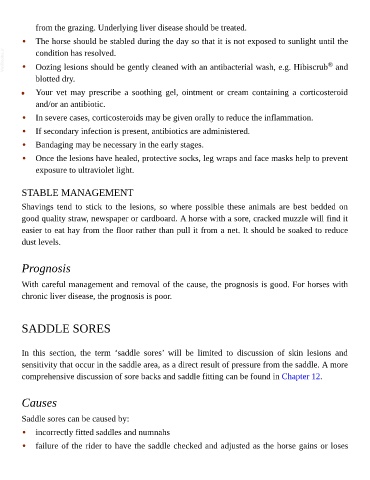Page 866 - The Veterinary Care of the Horse
P. 866
from the grazing. Underlying liver disease should be treated.
• The horse should be stabled during the day so that it is not exposed to sunlight until the
VetBooks.ir • condition has resolved. ®
Oozing lesions should be gently cleaned with an antibacterial wash, e.g. Hibiscrub and
blotted dry.
• Your vet may prescribe a soothing gel, ointment or cream containing a corticosteroid
and/or an antibiotic.
• In severe cases, corticosteroids may be given orally to reduce the inflammation.
• If secondary infection is present, antibiotics are administered.
• Bandaging may be necessary in the early stages.
• Once the lesions have healed, protective socks, leg wraps and face masks help to prevent
exposure to ultraviolet light.
STABLE MANAGEMENT
Shavings tend to stick to the lesions, so where possible these animals are best bedded on
good quality straw, newspaper or cardboard. A horse with a sore, cracked muzzle will find it
easier to eat hay from the floor rather than pull it from a net. It should be soaked to reduce
dust levels.
Prognosis
With careful management and removal of the cause, the prognosis is good. For horses with
chronic liver disease, the prognosis is poor.
SADDLE SORES
In this section, the term ‘saddle sores’ will be limited to discussion of skin lesions and
sensitivity that occur in the saddle area, as a direct result of pressure from the saddle. A more
comprehensive discussion of sore backs and saddle fitting can be found in Chapter 12.
Causes
Saddle sores can be caused by:
• incorrectly fitted saddles and numnahs
• failure of the rider to have the saddle checked and adjusted as the horse gains or loses

